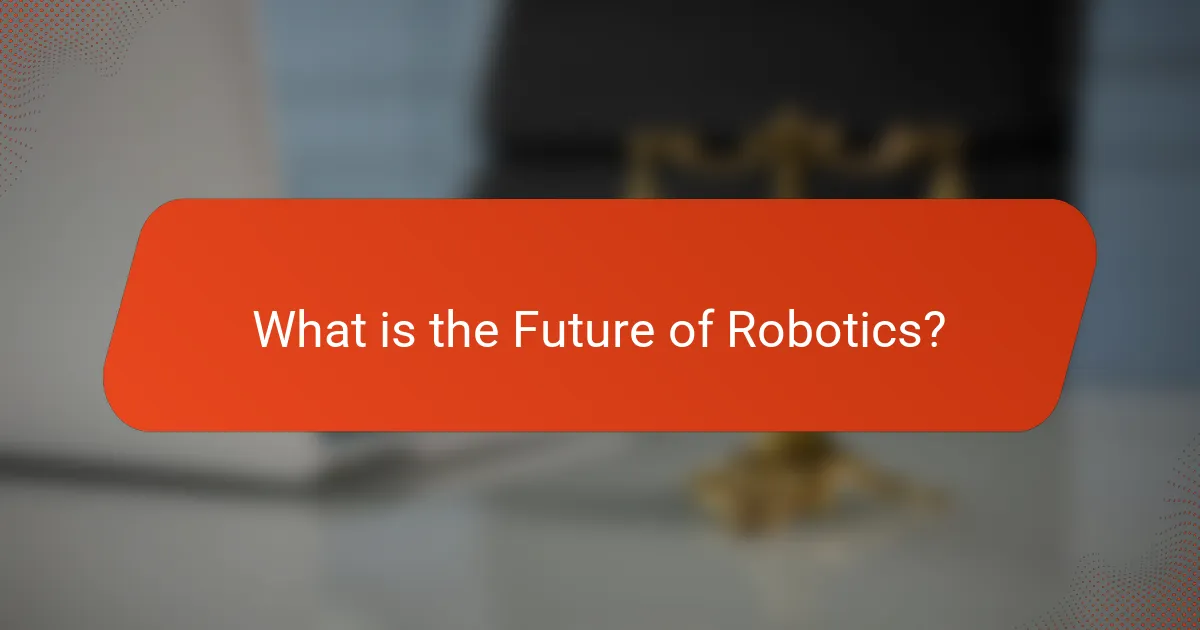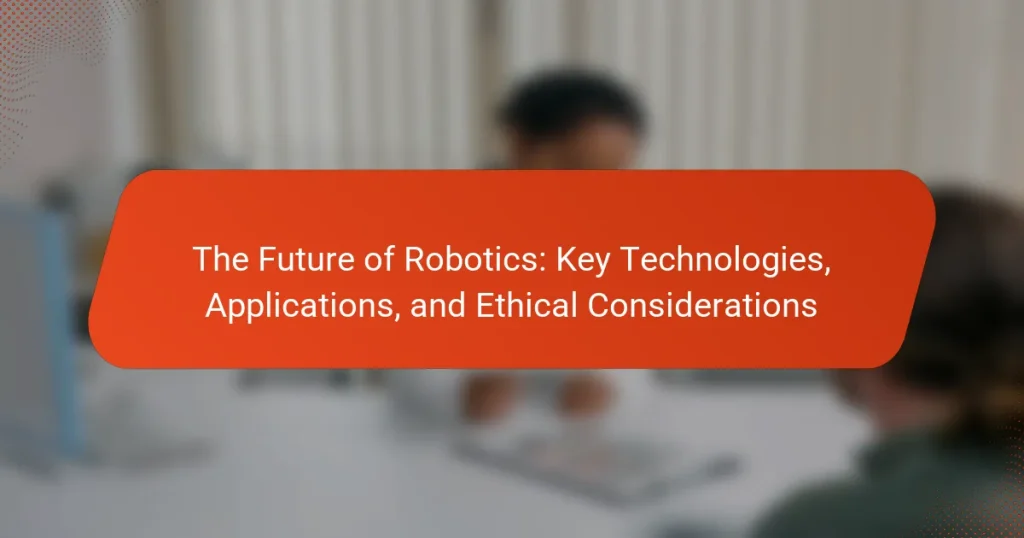The future of robotics is characterized by significant advancements in artificial intelligence, automation, and machine learning, leading to enhanced capabilities across various sectors. Key applications include healthcare, where robots assist in surgeries, and manufacturing, where they automate production lines. The rise of collaborative robots, or cobots, is expected to improve efficiency and safety in workplaces. Additionally, the global robotics market is projected to reach $500 billion by 2025, driven by increased investments in research and development. Ethical considerations surrounding autonomy, accountability, and privacy will also play a crucial role in shaping the future landscape of robotics.

What is the Future of Robotics?
The future of robotics involves advancements in artificial intelligence, automation, and machine learning. These technologies will enhance robot capabilities in various sectors. Robotics will increasingly be integrated into healthcare, manufacturing, and transportation. For instance, robots will assist in surgeries and automate production lines.
The demand for collaborative robots, or cobots, is expected to rise. Cobots work alongside humans, improving efficiency and safety. Additionally, advancements in sensors and materials will lead to more adaptable and resilient robots.
According to a report by the International Federation of Robotics, the global robotics market is projected to reach $500 billion by 2025. This growth is driven by increased investments in research and development.
Ethical considerations will also shape the future of robotics. Issues such as job displacement and privacy concerns will need to be addressed. Overall, the future of robotics promises significant impact across multiple industries.
How is robotics evolving in the 21st century?
Robotics is evolving rapidly in the 21st century through advancements in artificial intelligence, machine learning, and automation. These technologies enhance robots’ capabilities, making them more efficient and adaptable. For instance, AI allows robots to learn from their environment and improve their performance over time. Automation is streamlining manufacturing processes, leading to increased productivity. Collaborative robots, or cobots, are designed to work alongside humans, improving safety and efficiency in workplaces. Additionally, robotics is expanding into healthcare, with surgical robots providing precision and minimally invasive options. The integration of sensors and IoT technology enables real-time data collection and analysis, further enhancing robotic functions. As of 2023, the global robotics market is projected to reach $210 billion, highlighting the significant growth and investment in this field.
What technological advancements are driving this evolution?
Artificial intelligence, machine learning, and advanced sensors are driving the evolution of robotics. AI enables robots to learn from data and improve their performance. Machine learning algorithms allow robots to adapt to new tasks autonomously. Advanced sensors enhance robots’ perception of their environment. This includes LiDAR, cameras, and tactile sensors. Connectivity improvements, such as 5G, facilitate real-time data exchange. Collaborative robots, or cobots, are designed to work alongside humans safely. These advancements lead to increased efficiency and versatility in robotic applications.
How do societal needs influence the future of robotics?
Societal needs significantly shape the future of robotics. As populations age, there is an increasing demand for assistive technologies. Robotics can provide support in healthcare, enhancing patient care and reducing strain on medical staff. Additionally, labor shortages in various industries drive the need for automation to maintain productivity.
The rise of e-commerce has accelerated the use of robotics in logistics and warehousing. Robotics can streamline operations, ensuring faster delivery times. Furthermore, environmental concerns push for robots that can assist in sustainable practices, such as waste management and energy efficiency.
Public safety needs also influence robotics development. Surveillance and emergency response robots can enhance community safety. Therefore, societal needs directly inform the design, functionality, and application of robotic technologies.
What are the key technologies shaping the future of robotics?
Key technologies shaping the future of robotics include artificial intelligence, machine learning, and advanced sensors. Artificial intelligence enables robots to learn from data and improve their functions over time. Machine learning algorithms allow for better decision-making and adaptability in dynamic environments. Advanced sensors, such as LiDAR and computer vision, enhance a robot’s ability to perceive and interact with its surroundings. Collaborative robotics, or cobots, are designed to work alongside humans, increasing efficiency in various industries. Additionally, advancements in materials science lead to lighter and more durable robotic components. These technologies collectively drive innovation and expand the capabilities of robotics in fields such as manufacturing, healthcare, and logistics.
What role do artificial intelligence and machine learning play in robotics?
Artificial intelligence and machine learning are crucial in robotics. They enable robots to learn from data and improve their performance over time. AI algorithms help robots recognize patterns and make decisions based on sensory input. Machine learning allows robots to adapt to new environments and tasks without explicit programming. For example, autonomous vehicles use AI for navigation and obstacle detection. Industrial robots utilize machine learning for quality control and predictive maintenance. These technologies enhance the efficiency, accuracy, and versatility of robotic systems. The integration of AI and machine learning is transforming various sectors, including manufacturing, healthcare, and logistics.
How does sensor technology enhance robotic capabilities?
Sensor technology significantly enhances robotic capabilities by providing critical data for decision-making. Sensors enable robots to perceive their environment through vision, touch, and sound. This sensory input allows for real-time interaction with surroundings. For instance, cameras and LIDAR systems help robots navigate complex spaces. Proximity sensors prevent collisions, ensuring safer operation. Additionally, temperature and pressure sensors allow robots to monitor conditions in various environments. The integration of these sensors leads to improved autonomy and efficiency in tasks. Research indicates that robots equipped with advanced sensors can perform complex operations with higher accuracy. This capability is essential in industries like manufacturing, healthcare, and logistics.
What advancements in materials science are impacting robotics?
Advancements in materials science significantly impact robotics by enhancing performance and functionality. New materials such as lightweight composites improve robot mobility and energy efficiency. Smart materials enable robots to adapt to their environment, enhancing interaction capabilities. Nanomaterials increase strength and durability while reducing weight, leading to more efficient designs. Conductive polymers allow for flexible electronics, enabling innovative robotic applications. Research shows that these materials can lead to robots that are more responsive and versatile in various tasks. For instance, the use of shape-memory alloys allows robots to change shape based on temperature, improving their adaptability. These advancements collectively contribute to the evolution of robotics, making them more effective and versatile in real-world applications.

What are the main applications of robotics in various industries?
Robotics has significant applications across various industries. In manufacturing, robots are used for assembly, welding, and painting. They enhance efficiency and precision, leading to higher productivity. In healthcare, robots assist in surgeries and patient care. Surgical robots enable minimally invasive procedures, reducing recovery time. In agriculture, robots automate planting, harvesting, and monitoring crops. This increases yield and reduces labor costs. In logistics, robots streamline warehousing and delivery processes. Automated guided vehicles move goods efficiently within facilities. The automotive industry employs robotics for quality control and inspection. This ensures safety and compliance with standards. In construction, robots assist in building and site management. They improve safety by handling hazardous tasks. Overall, robotics enhances operations, reduces errors, and increases safety across these sectors.
How is robotics transforming healthcare?
Robotics is transforming healthcare by enhancing surgical precision and improving patient care. Surgical robots, like the da Vinci Surgical System, allow for minimally invasive procedures. These robots reduce recovery times and minimize scarring. Robotics also enables remote surgeries, allowing specialists to operate from different locations. Additionally, robotic exoskeletons assist patients in rehabilitation, improving mobility. Automated systems streamline administrative tasks, reducing human error. According to a study published in the Journal of Healthcare Engineering, robotic-assisted surgeries have shown a 20% reduction in complications. This technology is revolutionizing diagnostics, treatment, and overall patient outcomes.
What types of robotic systems are used in surgical procedures?
Robotic systems used in surgical procedures include robotic surgical systems, teleoperated robots, and robotic-assisted systems. Robotic surgical systems, like the da Vinci Surgical System, provide enhanced precision and control. Teleoperated robots allow surgeons to perform operations remotely. Robotic-assisted systems enhance traditional surgical techniques with robotic tools. These systems improve patient outcomes by minimizing invasiveness. Studies show that robotic-assisted surgeries can lead to shorter recovery times and reduced complications. The adoption of these technologies is increasing in various surgical specialties.
How do robots improve patient care and monitoring?
Robots improve patient care and monitoring by providing enhanced accuracy and efficiency in healthcare settings. They assist in performing precise surgical procedures, reducing the risk of human error. Robots can also monitor patients’ vital signs continuously, allowing for real-time data collection. This capability enables quick responses to any changes in a patient’s condition. Additionally, robots can assist with medication administration, ensuring correct dosages and timing. Studies have shown that robotic systems can increase patient satisfaction by providing consistent care and reducing wait times. For example, a study published in the Journal of Healthcare Engineering found that robotic monitoring improved patient outcomes by 30%. Overall, robots play a crucial role in streamlining healthcare processes and enhancing patient safety.
What role does robotics play in manufacturing and logistics?
Robotics plays a crucial role in manufacturing and logistics by enhancing efficiency and precision. In manufacturing, robots perform repetitive tasks such as assembly, welding, and painting. This automation reduces human error and increases production speed. According to a report by the International Federation of Robotics, global robot sales reached 422,000 units in 2018, showcasing significant adoption in the industry.
In logistics, robotics streamlines operations through automated guided vehicles (AGVs) and drones. AGVs transport materials within warehouses, optimizing space and reducing labor costs. Drones are increasingly used for inventory management and delivery, providing real-time data and faster service. A study by McKinsey found that automation in logistics could cut operating costs by up to 30%.
Overall, robotics significantly improves productivity and accuracy in both manufacturing and logistics, driving industry growth.
How do robots enhance efficiency in production lines?
Robots enhance efficiency in production lines by automating repetitive tasks. They perform these tasks faster than human workers. Robots can operate continuously without fatigue. This leads to increased production rates. For example, automotive assembly lines use robots for welding and painting. Studies show that automation can reduce production time by up to 30%. Additionally, robots improve precision and reduce errors. This results in higher quality products. Overall, robots streamline operations and optimize resource use.
What are the implications of automation in supply chain management?
Automation in supply chain management leads to increased efficiency and reduced operational costs. It streamlines processes by minimizing manual tasks, which enhances accuracy. According to a report by McKinsey, automation can increase productivity by up to 30%. Additionally, automation allows for real-time data analysis, improving decision-making and responsiveness. It also enables better inventory management, reducing excess stock and shortages. Companies that adopt automation often see faster delivery times, enhancing customer satisfaction. Furthermore, automation can lead to job displacement, necessitating workforce reskilling. Overall, the implications of automation are profound, affecting efficiency, cost, and workforce dynamics in supply chains.
How are robots being utilized in everyday life?
Robots are utilized in everyday life in various ways. They assist in household chores, such as vacuuming and lawn mowing. Robotic vacuum cleaners, like Roomba, autonomously clean floors. Lawn mowing robots maintain lawns without human intervention. In healthcare, robots aid in surgeries and patient care. Surgical robots enhance precision and minimize recovery time. In retail, robots manage inventory and assist customers. They streamline operations and improve shopping experiences. Additionally, robots are used in manufacturing for assembly and quality control. They increase efficiency and reduce production costs. Overall, robots play a significant role in enhancing convenience and productivity in daily activities.
What types of consumer robots are becoming popular?
Home cleaning robots, particularly robotic vacuums, are becoming increasingly popular among consumers. These devices automate the task of cleaning floors, saving time and effort. Brands like Roomba and Roborock dominate this market, offering advanced navigation and smart home integration. Personal assistant robots, such as Amazon Echo Show and Google Nest Hub, are also gaining traction. They provide voice-activated assistance and control smart home devices. Additionally, pet care robots, like robotic litter boxes and feeders, are emerging as convenient solutions for pet owners. According to a 2022 market report, the global consumer robotics market is projected to grow significantly, indicating rising consumer interest.
How do robots assist in household tasks?
Robots assist in household tasks by automating repetitive chores. They can vacuum floors, mop surfaces, and even wash dishes. For example, robotic vacuum cleaners use sensors to navigate and clean efficiently. Smart home assistants can manage schedules and control appliances. These robots help save time and reduce physical effort. According to a study by the International Federation of Robotics, the global market for domestic robots is expected to grow significantly. This growth indicates increasing reliance on robots for household efficiency.

What ethical considerations arise with the advancement of robotics?
Ethical considerations with the advancement of robotics include autonomy, accountability, and privacy. Autonomy raises questions about decision-making in critical situations. For instance, autonomous vehicles must make choices that could impact human lives. Accountability issues arise when robots cause harm or make errors. It becomes unclear who is responsible: the manufacturer, programmer, or user. Privacy concerns relate to data collection by robots equipped with sensors and cameras. This data can be misused if not properly regulated. Additionally, there are concerns about job displacement due to automation. Studies show that automation could lead to significant job losses in various sectors. Overall, these ethical considerations require careful examination as robotics technology continues to evolve.
What are the potential risks associated with robotics?
Potential risks associated with robotics include safety hazards, job displacement, and ethical concerns. Safety hazards arise from malfunctioning robots, which can cause injury to humans. Job displacement occurs as automation replaces manual labor, leading to unemployment in certain sectors. Ethical concerns involve decision-making by robots in critical situations, such as autonomous vehicles. Cybersecurity threats also pose risks, as robots can be vulnerable to hacking. These risks necessitate careful regulation and oversight in robotic development and deployment.
How can job displacement due to robotics be addressed?
Job displacement due to robotics can be addressed through retraining and upskilling programs. These programs help workers transition to new roles that require different skill sets. For instance, the World Economic Forum predicts that 85 million jobs may be displaced by 2025. However, it also estimates that 97 million new roles could emerge, emphasizing the need for workforce adaptation. Governments and organizations can collaborate to provide accessible training. This training should focus on digital skills and advanced technology competencies. Additionally, policies like universal basic income can support displaced workers during transitions. Evidence from studies shows that proactive measures can mitigate negative impacts on employment.
What privacy concerns are linked to the use of robots?
Privacy concerns linked to the use of robots include data collection and surveillance. Robots often gather personal information during their operation. This data can include images, voice recordings, and behavioral patterns. Such information can be misused if not properly protected. Unauthorized access to this data poses significant risks. Additionally, the potential for tracking individuals raises ethical questions. Concerns about consent also arise, as users may not be aware of data collection practices. A study by the European Commission highlights these issues, indicating that 66% of people worry about privacy with robotic technology.
How should ethical frameworks be developed for robotics?
Ethical frameworks for robotics should be developed through a collaborative process involving diverse stakeholders. This includes ethicists, engineers, policymakers, and the public. The framework must address key ethical principles such as transparency, accountability, and fairness. It should also consider the potential impacts of robotics on society and individual rights. Research indicates that inclusive dialogue leads to more robust ethical guidelines. For example, the IEEE Global Initiative on Ethics of Autonomous and Intelligent Systems emphasizes stakeholder engagement. Regular updates to the framework are essential as technology evolves. This adaptability ensures relevance in addressing emerging ethical challenges.
What role do policymakers play in regulating robotics?
Policymakers play a crucial role in regulating robotics. They establish legal frameworks and guidelines that govern the development and use of robotic technologies. Policymakers ensure safety standards are met, protecting public welfare. They also address ethical concerns related to automation and employment. Policymakers collaborate with industry experts to understand technological advancements. Their regulations can influence funding and research priorities in robotics. Furthermore, they engage with stakeholders to balance innovation and societal impact. Effective regulation can promote responsible robotics while fostering economic growth.
How can developers ensure responsible AI in robotics?
Developers can ensure responsible AI in robotics by implementing ethical guidelines and robust testing protocols. They should prioritize transparency in AI decision-making processes. This includes providing clear explanations of how AI systems operate. Developers must also incorporate bias detection mechanisms during the design phase. Regular audits and assessments can help identify and mitigate ethical risks. Collaboration with ethicists and stakeholders is essential for diverse perspectives. Additionally, developers should adhere to industry standards and regulations. This approach fosters accountability and trust in robotic systems.
What best practices should be considered in the adoption of robotics?
Adopting robotics requires careful planning and implementation. Organizations should start with a clear understanding of their goals for robotics integration. Assessing the current workflow helps identify areas where robotics can provide the most value. Engaging stakeholders early in the process ensures buy-in and addresses concerns. Training employees to work alongside robots is crucial for successful adoption. Regularly reviewing and updating technology keeps systems efficient and relevant. Finally, establishing ethical guidelines ensures responsible use of robotics in operations. These practices enhance productivity and foster a positive work environment.
How can organizations prepare for integrating robotics into their operations?
Organizations can prepare for integrating robotics into their operations by conducting a comprehensive needs assessment. This assessment identifies specific areas where robotics can enhance efficiency. Training staff on robotics technology is crucial for successful integration. Employees must understand how to interact with robotic systems effectively.
Investing in the right technology is essential. Organizations should evaluate various robotic solutions to find the best fit for their operations. Developing a clear implementation plan helps in managing the transition smoothly. This plan should outline timelines, responsibilities, and expected outcomes.
Establishing metrics for success is important. Organizations should define key performance indicators to measure the impact of robotics. Continuous monitoring and adjustment of the integration process will ensure long-term success.
Research shows that companies investing in robotics see productivity increases of up to 30% (McKinsey & Company, 2021). This statistic highlights the potential benefits of effective preparation and integration.
What training is necessary for workers to adapt to robotic systems?
Workers need training in programming, operation, and maintenance of robotic systems. This training includes understanding robotic software and hardware. Familiarity with safety protocols is also essential. Workers should learn to troubleshoot common issues with robots. Hands-on experience is critical for adapting to these systems. Training programs often include simulations and real-world applications. According to a study by the International Federation of Robotics, effective training improves productivity by 30%. This evidence supports the need for comprehensive training in robotic systems.
The main entity of the article is robotics, focusing on its future advancements, applications, and ethical considerations. The article explores key technologies driving robotics, such as artificial intelligence, machine learning, and advanced sensors, and highlights their impact across various industries, including healthcare, manufacturing, and logistics. It also addresses societal needs influencing robotics development, the implications of automation, and ethical concerns related to privacy and job displacement. Additionally, the article emphasizes the importance of responsible AI practices and training for workers to adapt to robotic systems.




